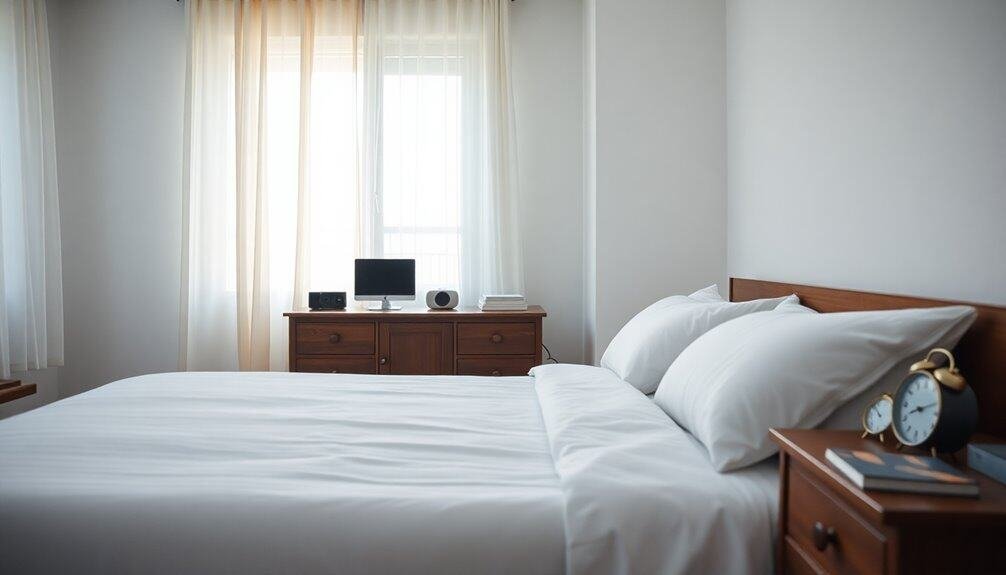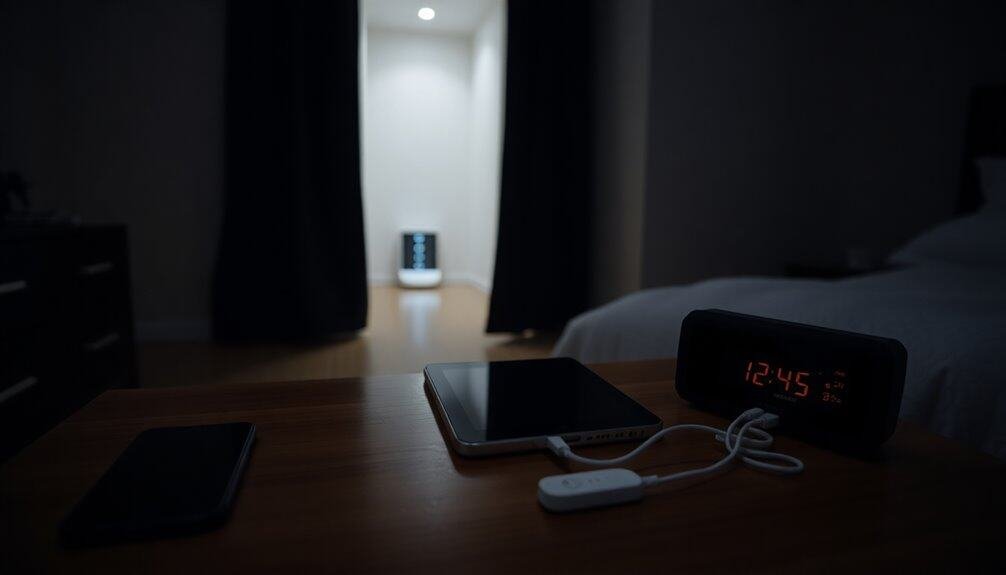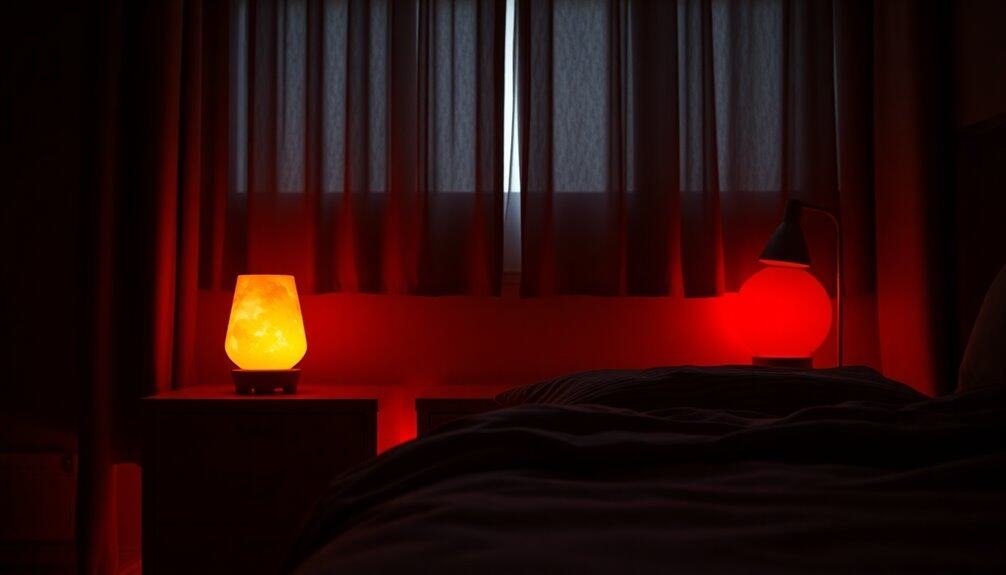How to Reduce EMF Exposure at Night
Position your bed away from walls and unplug electronic devices to reduce EMF exposure at night. Use organic cotton bedding with silver fibers and keep electric clocks six feet away from the bed.
Turn off Wi-Fi routers before sleep and opt for warm-toned LED bulbs to minimize emissions. Consider EMF shielding curtains and grounding techniques for added protection.
Disclaimer: As an affiliate, I may collect a share of sales from the links on this page.
Bedroom Location and Layout

When arranging your bedroom, it’s crucial to contemplate both the layout and the location to minimize electromagnetic field (EMF) exposure.
Start by removing electronic devices like TVs and computers from the space; they emit significant EMFs. Place your bed away from walls and electrical wiring to reduce proximity to EMF sources. Moreover, keeping the bedroom free of EMF sources promotes better sleep quality and overall well-being. Additionally, maintaining a distance of 15 to 20 feet from EMF sources like WiFi routers can further enhance your sleeping environment.
Use grounding techniques by grounding the bed frame for added benefits. Avoid electric heating options, such as heated blankets, and switch off power sources when possible. Finally, confirm your Wi-Fi router’s positioned away from the bedroom, further decreasing EMF exposure while you sleep.
Natural Materials for Furnishings
Choosing the right materials for your bedroom furnishings can greatly influence your EMF exposure levels.
Opt for organic cotton bedding, which often incorporates silver fibers, providing up to 99% EMF blocking. Additionally, consider using conductive textiles for grounding purposes as they can enhance your protection against EMF exposure while maintaining comfort. These textiles utilize conductive fabrics woven with metal threads to effectively absorb and deflect electromagnetic radiation.
Consider using curtains made from silver-coated yarns to create a barrier against EMF radiation.
For furniture, look for upholstery made from EMF shielding fabrics or natural woods, like graphite-infused wood, which may possess protective properties.
Incorporate crystals, such as black tourmaline, in your decor for their natural absorption qualities.
Managing Electronic Devices

To effectively minimize EMF exposure at night, you can begin by managing the placement and utilization of electronic devices in your bedroom.
Remove devices like cell phones and tablets, keeping them outside for sleep. Move electric clocks and appliances at least six feet away from the bed. Shift to wired internet connections to decrease emissions. Turning off your Wi-Fi router at night creates a calmer, EMF-free sleeping space, as long-term health effects of EMF radiation remain under investigation. Activate airplane mode on unused devices, and turn off all electronics before bed. Designate your bedroom as a tech-free zone and consider using power strips for easy control.
These actions greatly reduce EMF exposure, enhancing your sleep quality.
Adjustments to Bedding and Furnishing
While evaluating your bedroom setup, consider how adjustments to your bedding and furnishings can considerably lower EMF exposure.
Opt for silver-infused blankets, which can reduce EMF by over 99%. Choose furniture made from wood, as it doesn’t conduct EMFs. For mattresses, select those constructed from natural fibers to enhance shielding.
Incorporating shielding materials or coatings in bed frames can further block EMFs. Implementing grounding techniques is also effective.
Additionally, using EMF shielding blankets and curtains provides extra layers of protection. These adjustments create a more EMF-safe sleeping environment, improving your overall sleep quality while reducing potential health risks.
Lighting Modifications

Lighting choices in your bedroom considerably impact EMF exposure at night. Opt for dim red lighting; it minimizes blue light, promoting better sleep.
Avoid fluorescent bulbs, as they produce higher EMFs—choose LED alternatives instead. LED lights emit less EMF than traditional options.
Use warm-toned lighting to enhance relaxation and sleep quality. Implement dimmable systems to adjust light intensity, further reducing exposure.
Consider candles or oil lamps for EMF-free lighting. Make certain lights are placed away from sleeping areas and utilize low-voltage lighting systems to lower emissions.
Smart switches can automate turning off lights, enhancing your nightly routine for reduced exposure.
Electrical System Considerations
Electrical system considerations play an essential role in minimizing your EMF exposure at night. Reducing wire separation keeps hot and neutral wires close together, which lowers stray magnetic fields.
You can use shielding materials like mu-metal to absorb and redirect these fields. Properly grounded conductive materials, such as metal mesh, help redirect electric fields away from living spaces.
Install cut-off switches to disconnect electricity to circuits during sleep hours. For smart meters, make sure they’re away from living areas and explore alternatives that avoid wireless communication.
Lifestyle Changes for EMF Reduction
To effectively reduce EMF exposure at night, you can implement several practical lifestyle changes.
Move all electronic devices, like smartphones and laptops, away from your bed. Use an analog alarm clock instead of your phone, and keep wireless devices, such as routers, several feet from your sleeping area.
Set devices to airplane mode or power them off before bed. Designate your bedroom as a tech-free zone, eliminating unnecessary electronics.
Replace digital activities with calming routines, and prioritize a consistent sleep schedule. Educate your household about device limits, and consider using power strips to conveniently cut off multiple devices during the night.
Incorporating Shielding Strategies
Incorporating shielding strategies greatly enhances your nighttime EMF reduction efforts.
Bed canopies effectively block EMFs from most directions, except beneath the bed. EMF-blocking curtains reduce external fields from sources like power lines.
To create a Faraday cage effect, consider materials like copper mesh or aluminum foil, which can completely shield a room from EMFs. Layering shielding materials—such as copper and aluminum—ensures better protection against radiofrequency radiation.
For added safety, utilize shielded bedding, EMF-blocking alarm clocks, and special paints on walls.
Creating a Relaxing Sleep Environment
Establishing a relaxing sleep environment is essential for achieving quality rest.
Here are key considerations to optimize your bedroom:
- Lighting: Use soft, warm lighting to signal sleep readiness.
- Color Psychology: Opt for calming hues like blues or greens.
- Decluttering: Remove unnecessary items to enhance mental clarity.
- Biophilic Elements: Incorporate natural materials or plants for a soothing atmosphere.
Frequently Asked Questions
How Does EMF Exposure Affect Sleep Quality?
EMF exposure negatively affects your sleep quality by suppressing melatonin levels, increasing stress and cortisol, and disrupting sleep-wake cycles. These factors make it harder for you to fall asleep and stay asleep throughout the night.
Can Pets Increase EMF Levels at Night?
Yes, pets can contribute to EMF levels, especially with wireless devices like collars. Their proximity to electronics amplifies exposure. Be mindful of where they spend time, as this can influence overall EMF levels in your home.
Is There a Safe Distance From EMF Sources?
To minimize EMF exposure, keep a distance of at least 1–2 feet from household appliances and devices. For power lines, staying more than 300 feet away guarantees EMF levels are generally indistinguishable from background levels.
How Often Should I Monitor EMF Levels?
You should monitor EMF levels at least annually, especially after changes in electronic setups or room usage. For sensitive individuals or increased device density, consider checking every 3–6 months to guarantee ongoing safety and comfort.
Are There Specific Plants That Reduce EMF Exposure?
Yes, specific plants like cacti, snake plants, and aloe vera can help reduce EMF exposure. They naturally absorb radiation and improve air quality, making them a great addition to your indoor spaces for healthier living.
Conclusion
Reducing EMF exposure at night involves strategic bedroom design and the use of natural materials. Manage electronic devices, adjust lighting and bedding, and incorporate shielding measures to minimize exposure. Embrace these practices for a restful, tech-free sleep environment.



